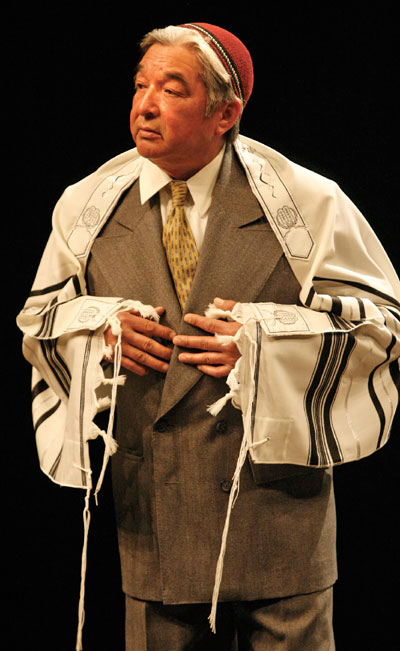|
Graham Greene made me cry last week.
No, he didn't yell or insult or berate me; in fact, this has nothing to do with me at all and everything to do with him. Graham Greene made me cry because he did what very few of his peers in acting can do—walk onto a darkened stage and pull you inside the skin of a character so completely you feel the sweat dripping off his brow; the ache of his muscles after a 12-hour day hurling sacks of California-picked barley; his giddiness while caressing a newborn pup.
Oneida actor Graham Greene, best known to mainstream America for his Academy Award nominated performance as the Lakota dude with the funky hair in Dances With Wolves, is exceeding expectations once again. Not by taking on a politically charged movie role. Not by marching arm in arm with camera hungry White "activists" striving to prove their inner-Indian by showing solidarity with da'-cause-d'jour.
Graham Greene is an artist in the truest sense of the word; and as any bona fide artist he is unyoking his creative tether by showing that an actor, a proudly Indian actor, can take on two of the juiciest roles in theatre and make them uniquely his own. Juicy roles that aren't, by the way, Indian at all; juicy roles that call for a Jewish merchant and a slow-witted drifter; juicy roles written by William Shakespeare and John Steinbeck, one White guy who never even heard of Indians and a second White guy who had heard of Indians but never wrote about them.
It isn't hyperbole to say that it is truly revolutionary that Greene, best known as the Lakota dude with the funky hair in Dances With Wolves, is not only starring in the 2007 Canadian Stratford Festival's productions of The Merchant of Venice and Of Mice and Men, but while doing so receiving standing ovations from the august Stratford audiences and snarkilicious theatre critics from both sides of the border.
 |
This isn't a review of how well he assumes the character of the scornful Shylock or even how he managed to portray Lenny with restrained pathos. That's easy. While watching Of Mice and Men, I was awed by what I didn't witness onstage or in the audience. I sat, quietly but nosily, listening to the comments of fellow theatre-goers before the show; I sat, quietly but nosily, straining to hear what folks were saying during the intermission and at the conclusion. And what I heard—better yet—what I didn't hear is what makes what he did so, well, revolutionary. And this isn't hyperbole either.
Uncharacteristic for a Stratford crowd, the audience voraciously cheered when he bowed for his curtain call. They clapped and whistled and yelled because in two hours Graham Greene was Lenny Small and we cried, hundreds of us, at the simple goliath victimized by a caste-based culture of bigotry and self loathing. How easy it would have been for him to chew the scenes from beginning to end; the dumb or dumber loser nonplussed by his awful fate. No way, this guy is a pro and hammy he ain't.
So we wept and we cheered. And not once…not once did anyone anywhere identify the fact that Oneida actor Graham Greene, best known as the Lakota dude with the funky hair in Dances With Wolves, is Native. Not once. And this is a good thing indeed—actually, it's more than that. Because the day a guy who once was relegated to wearing a breechcloth as Kevin Costner's second fiddle can become a Jewish-Italian Merchant or a Depression-era migrant worker and knock the livin' socks off people in the process is the day I say, yeah, there is something happening here.
Without banners, silly White new-agers, or tom-toms beating anywhere. Now that's revolutionary.
Photos - David Hou and Richard Bain
|
